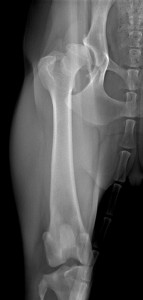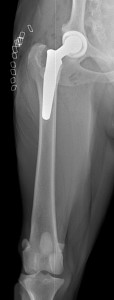 Molly was presented to the Orthopedic Division of the University of Missouri Small Animal Surgical Service with a complaint of being lame in her right rear leg and prematurely tiring during activity. Molly was a 4-year-old English setter and well trained to hunt birds, but she was getting increasingly stiff after a hard day out in the field. Molly’s owners were very worried about her level of discomfort and her inability to do the things she wanted to do despite being so young. Her veterinarian took X-rays of her hips, suspecting that hip dysplasia might be the source of her discomfort, and referred her to the Surgery group at the University of Missouri. Upon presentation, we agreed that Molly’s hips were quite painful, and upon taking more X-rays, confirmed the diagnosis of bilateral hip dysplasia.
Molly was presented to the Orthopedic Division of the University of Missouri Small Animal Surgical Service with a complaint of being lame in her right rear leg and prematurely tiring during activity. Molly was a 4-year-old English setter and well trained to hunt birds, but she was getting increasingly stiff after a hard day out in the field. Molly’s owners were very worried about her level of discomfort and her inability to do the things she wanted to do despite being so young. Her veterinarian took X-rays of her hips, suspecting that hip dysplasia might be the source of her discomfort, and referred her to the Surgery group at the University of Missouri. Upon presentation, we agreed that Molly’s hips were quite painful, and upon taking more X-rays, confirmed the diagnosis of bilateral hip dysplasia.
 Canine hip dysplasia is a multi-factorial disease that results in the gradual destruction of the hip joints. Over time, the cartilage is lost and the ball and socket components of the hip remodel and become misshapen. If not severe, it can be successfully managed non-surgically. But for dogs like Molly, where the clinical signs are advanced and quality of life is being lost, the gold standard care is a total hip replacement. We performed a replacement of Molly’s right hip on Feb. 9, 2012.
Canine hip dysplasia is a multi-factorial disease that results in the gradual destruction of the hip joints. Over time, the cartilage is lost and the ball and socket components of the hip remodel and become misshapen. If not severe, it can be successfully managed non-surgically. But for dogs like Molly, where the clinical signs are advanced and quality of life is being lost, the gold standard care is a total hip replacement. We performed a replacement of Molly’s right hip on Feb. 9, 2012.
Six months after undergoing the total hip replacement, Molly was fully recovered and back in the field with her owner, this time without the discomfort of trying to run on a badly diseased hip. She was able to run and hunt pain-free once more. Because Molly’s other hip is also affected, she may need surgery on that side in time. But for now, Molly is enjoying life again.
 Learn more about total hip replacements in dogs and what the University of Missouri’s Small Animal Surgical Service can do to help your dog on our Orthopedic Surgery page.
Learn more about total hip replacements in dogs and what the University of Missouri’s Small Animal Surgical Service can do to help your dog on our Orthopedic Surgery page.



